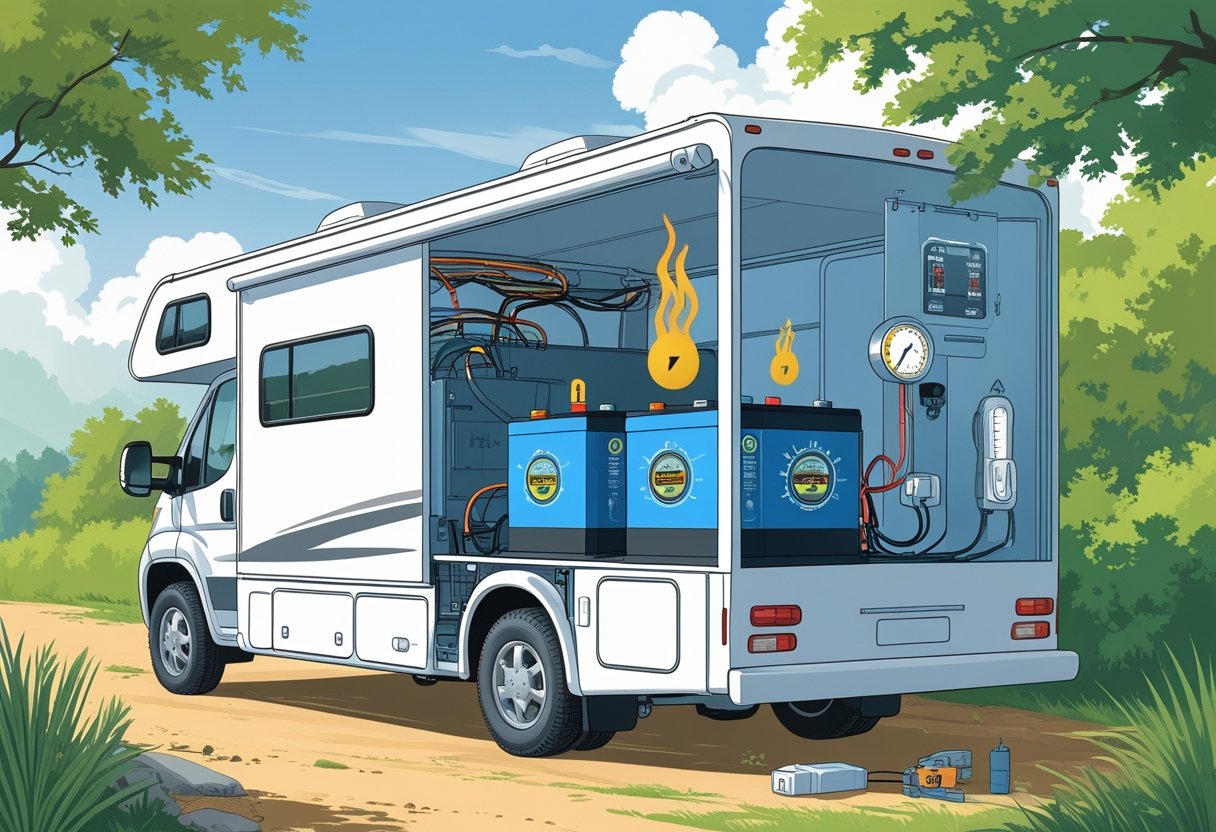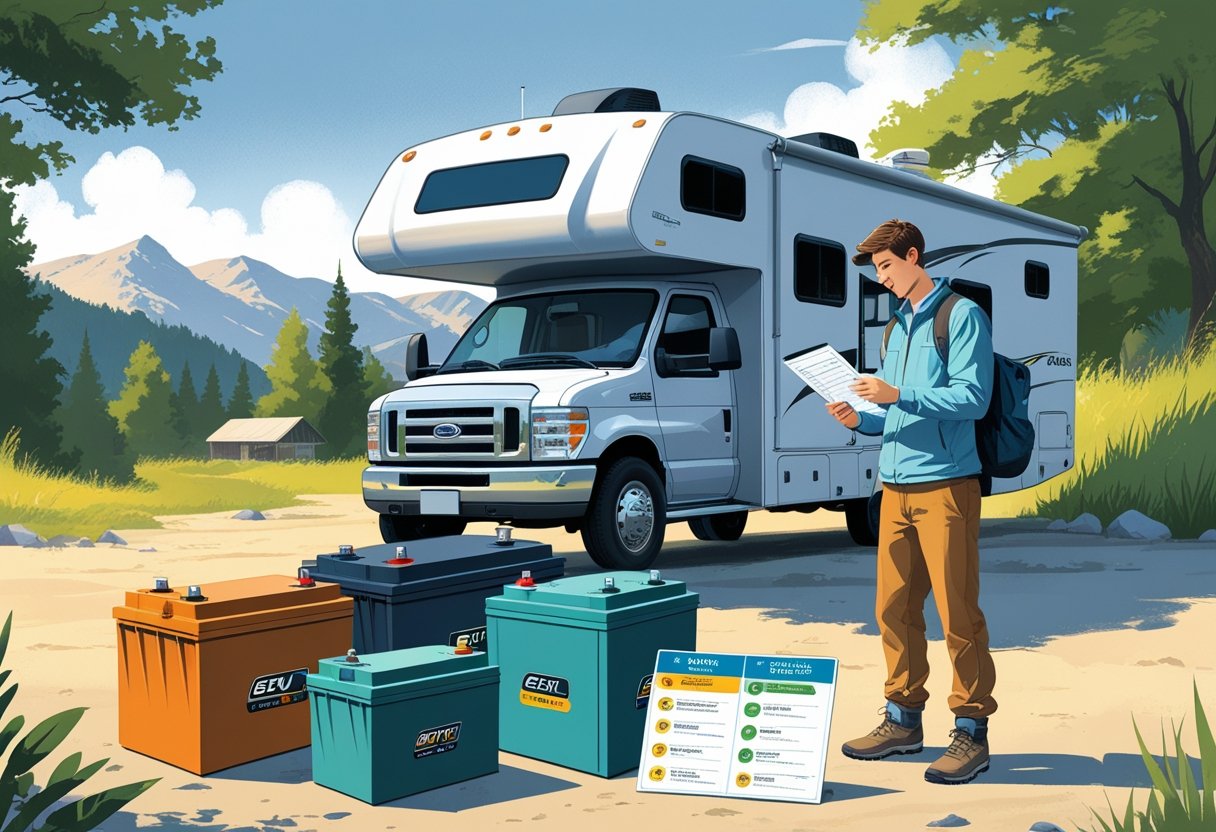Would you like to save this article?
If you’re shopping for a new RV battery, you might be wondering if gel batteries are the right choice for your setup. Gel batteries can be a good option for RV owners who want a low-maintenance, spill-proof, and durable power source that can handle a lot of movement and bumps. Unlike regular wet cell batteries, gel batteries don’t leak fumes and are resistant to shocks and vibrations, making them a great fit for life on the road.
You’ll also appreciate that gel batteries are virtually maintenance-free, so you don’t have to mess with adding water or checking fluid levels. But like any option, they have their own pros and cons, which can affect your overall RV experience. Stick around to find out if a gel battery is right for your travels and how it compares to other RV battery types.
What Are Gel Batteries?
Gel batteries are a type of deep cycle battery often used in RVs. They use a thick, gelled electrolyte to store energy and provide power. These batteries come with advantages over other types, but they also have some trade-offs that may impact your choice.
How Gel Batteries Work
Gel batteries use a mix of sulfuric acid and silica to form a jelly-like substance inside the battery. This gel keeps the electrolyte stable and sealed, so you don’t have to worry about leaks.
You can place gel batteries in almost any position because the gel doesn’t spill. They also don’t create a lot of fumes, making them safer to use in enclosed spaces like RVs.
These batteries recharge more slowly than some other types. It’s important to use the right charger, because charging a gel battery with too much current can damage it. They are pretty resistant to vibrations and handle tough road conditions well. Most RV owners like how little maintenance they require.
Types Of RV Batteries
RVs use three main types of batteries: flooded lead-acid, absorbent glass mat (AGM), and gel batteries. Flooded lead-acid batteries use a liquid electrolyte. They need regular checks and water top-offs.
AGM batteries hold their electrolyte in fiberglass mats. They charge faster and are a bit sturdier. Both AGM and gel batteries are sealed, so you don’t have to worry about spills.
Lithium batteries are becoming more popular in RVs. These are lighter, recharge fast, and last a long time, but cost a lot more.
Gel Versus Other Battery Technologies
Gel batteries are heavier than similar-sized lithium batteries, which can impact your RV’s overall weight. Compared to AGM batteries, gel batteries last longer if you take care of them, but they don’t deliver power as quickly.
AGM batteries are cheaper and work better when you need quick bursts of power, like for starting engines. Gel batteries, on the other hand, handle deep discharges better and are good for steady power needs in your RV setup.
Key Benefits Of Gel Batteries For RVs
Gel batteries can be a solid choice for RV owners who want easy care, steady performance, and extra safety. They work well in different environments and handle life on the road with fewer hassles than standard flooded batteries.
Maintenance-Free Operation
With gel batteries, you mostly just set them up and forget about them. There’s no need to check the water level, top off fluids, or clean up messy acid spills. The sealed design of these batteries means you can go months, sometimes years, without having to do any maintenance. This makes them a great choice if you want to avoid routine battery chores and spend more time enjoying your RV.
You also don’t have to worry about corrosion on the battery posts like you might with some lead-acid types. That’s because gel batteries use a thick, gel-like substance instead of liquid, so everything stays inside the case.
Because of their simple setup, you can install gel batteries in those hard-to-reach RV compartments and not stress over future upkeep. Many RV owners enjoy the hassle-free use that maintenance-free batteries provide, especially when traveling long distances.
Longer Lifespan
Gel batteries usually last longer than traditional wet cell batteries if you take care of them. Their internal gel holds up well against deep discharges, which are common when powering RV appliances. The extra durability means you won’t have to replace them as often as regular batteries.
You can expect gel batteries to provide steady output over more cycles. The gel inside helps prevent sulfation, a common issue that causes other batteries to fail early. Fewer replacements mean fewer trips to the store and more time on the road.
The thick gel also protects the cells from bumps, shakes, and vibrations, which can shorten the life of other battery types. That makes gel batteries a good investment if you travel rough roads or park your RV where movement happens regularly.
Safety Features
One of the best things about gel batteries is that they don’t leak acid because they’re sealed tight. You can even mount them sideways without any risk of spills. This protects your RV’s battery compartment and surroundings from damage.
Gel batteries don’t let out harmful fumes, unlike some flooded batteries, so you don’t need special venting. That means you can safely use them inside your RV and not worry about air quality issues. For those who have pets or kids onboard, this is a big plus.
They’re also tough against shocks and vibrations, so you’re less likely to have problems during bumpy rides.
Gel Batteries Vs. AGM And Lithium Batteries
If you’re trying to decide which type of battery is best for your RV, you’ll want to know how gel batteries compare with AGM and lithium batteries. Each battery type works differently, lasts a different amount of time, and costs more or less up front.
Performance Differences
Gel batteries provide steady power and don’t require a lot of maintenance. They’re sealed, so you don’t have to check water levels. The gel material inside helps make them safer if your RV gets bumped around. However, gel batteries are sensitive to how fast you charge them, and charging them too quickly can damage them.
AGM batteries, which use a glass mat to hold the battery acid, are similar to gel batteries but can usually handle higher charge rates. That means you can sometimes charge them faster on the road. Lithium batteries stand out most for their performance. They are lighter, supply more usable energy, withstand deeper discharges, and can be charged very quickly. If you run lots of appliances or need a faster recharge, lithium batteries are often preferred.
A quick look at the main differences:
| Battery Type | Power Delivery | Maintenance | Charging Speed | Weight |
|---|---|---|---|---|
| Gel | Good | Low | Slow | Moderate |
| AGM | Good | Low | Medium | Moderate |
| Lithium | Excellent | Very Low | Fast | Light |
Durability And Lifespan
Gel batteries last longer than regular lead-acid batteries if you treat them carefully. They usually handle fewer charging cycles than lithium, but often outlast wet-cell batteries if not exposed to overcharging or freezing. Extreme temperatures can reduce gel battery life.
AGM batteries are tough and more resistant to vibration, making them popular for RVs. They can handle slightly more cycles than gel, but also don’t like being deeply discharged. Lithium batteries are leaders in lifespan and durability. They regularly last thousands of cycles, are highly resistant to deep discharge damage, and handle temperature swings better, although extreme cold can lower performance.
AGM and gel batteries both offer reliable durability, but lithium batteries generally have a much longer usable life.
Cost Comparison
Gel batteries are less expensive up front than lithium batteries but tend to cost more than standard lead-acid batteries. AGM batteries are priced similarly to gel, sometimes a little cheaper. Both are good choices if you need to keep your initial investment low.
Lithium batteries are costly at first—usually two or three times more than gel or AGM batteries. For example, a 100Ah lithium battery can cost between $600-$900, while a gel battery of similar size usually costs $200-$400. Even though lithium batteries are expensive, they last much longer and may save you money in the long run because you won’t need to replace them as often.
AGM and gel batteries are more affordable for short-term needs, while lithium batteries pay off over time if you plan to keep your RV for many years.
Downsides Of Using Gel Batteries In RVs
Gel batteries come with a few important drawbacks. These can affect how well they work in your RV, and how much money and effort you’ll have to put in over time.
Charging Sensitivity
Gel batteries are sensitive to how they’re charged. If you use the wrong type of charger or charge them too fast, you can ruin the battery for good. Overcharging or using a charger made for regular wet-cell batteries can cause permanent internal damage.
You’ll need a smart charger that’s designed for gel batteries and can match their specific charging profile. This often means an extra expense and a little research.
Fast-charging is not recommended. Gel batteries do best with slower, more controlled charging. This makes them less suitable if you want to recharge quickly while on a tight schedule.
Lower Current Output
Gel batteries can’t deliver high bursts of power all at once. If you need a quick, strong source of energy (like for starting large appliances or using high-powered tools), they may fall short. Their thicker electrolyte slows how quickly electricity moves through the battery.
Here’s a simple comparison:
| Battery Type | Burst Output | Best Use |
|---|---|---|
| Gel | Lower | Steady deep cycle use |
| AGM | Higher | Quick power needs |
This lower current output isn’t a problem if you’re only running lights, fans, or small electronics. But if your RV needs a big surge of power on demand, gel batteries might not be the best fit.
Initial Investment
You’ll likely spend more when you first buy gel batteries compared to regular flooded lead-acid or even AGM batteries. The upfront price can be a shock if you’re used to cheaper options.
While gel batteries last longer if treated well, that higher initial cost may not make sense for everyone. You’ll also need to budget for a compatible charger or upgrade your current one to work safely with gel batteries.
Before you go all-in, it’s smart to compare costs and features with other battery options.
How To Choose The Right Battery For Your RV
Picking a good battery affects how long you can camp without hookups and how reliable your RV system will be. Different batteries suit different travel styles, climate conditions, and budgets.
Assessing Power Needs
Start by making a list of everything you’ll power with the battery—lights, fridge, water pump, and electronics. Check each appliance’s watt or amp rating and figure out how long you use them daily. Add up these numbers to estimate your total daily energy use in amp-hours (Ah).
If you often use power-hungry devices like AC units or microwaves, you’ll need a battery bank with a higher capacity. Keep in mind, some batteries, like lead-acid, shouldn’t be discharged below 50%, so you might need a larger size.
Climate Considerations
The weather you camp in matters more than many realize. Cold temperatures can lower the performance and life of many battery types, especially flooded lead-acid ones. Gel batteries and AGM batteries handle temperature swings a bit better, but even they have limits.
If you camp where it freezes, lithium batteries give you the best results but can be pricey. Gel batteries do okay in varied temps and are sealed, so you don’t worry about spills. It helps to install your batteries inside or in insulated compartments if you expect extreme temperatures.
Budget Factors
Costs can add up quickly, so plan your budget. Flooded lead-acid batteries are the cheapest upfront but need regular maintenance. Gel batteries cost more than standard lead-acid but are maintenance-free and spill-proof.
Lithium batteries are the most expensive but last longer and need little attention. Look beyond just the purchase price—factor in lifespan, maintenance, and possible replacement costs. Maintenance-free batteries may save you money and time over a few years.
Tips For Maintaining Gel Batteries In Your RV
Taking good care of gel batteries helps keep your RV powered and ready when you need it. You can make your battery last longer by following the right steps.
Proper Charging Techniques
Gel batteries are sensitive to overcharging, so it’s important to use a charger made just for gel batteries or one with a gel setting. A regular charger can damage the battery and shorten its life. If you use solar panels, make sure the controller is set to gel mode. This keeps the voltage in the right range and protects the battery.
Never let the charge drop too low. If the voltage falls below 12.2V, recharge right away to avoid deep discharge damage. Charging slowly helps prevent overheating and extends battery life. Quick charging isn’t recommended because it can cause the gel inside to break down.
A smart charger is a great investment. It will adjust the charging rate automatically, so you don’t have to worry about overcharging. Always double-check your battery charger’s manual for the correct settings.
Easy Charging Tips
- Use chargers labeled for gel batteries
- Monitor voltage regularly (don’t go under 12.2V)
- Avoid fast charging modes
- Turn off electronics while charging
Storage Best Practices
Proper storage makes a big difference for gel batteries, especially if you won’t be using your RV for a while. Always store batteries in a cool, dry place. High heat shortens battery life, while freezing can cause permanent damage. Before storing, give the battery a full charge, since leaving it low can cause it to fail.
Disconnect the battery from your RV to prevent slow drains from your appliances. It’s a good idea to put your gel battery on a trickle charger during storage. This keeps the voltage steady without overcharging.
Check your gel battery at least once a month while it’s stored. If the voltage drops, charge it back to full.
| Storage Tip | Why It Matters |
|---|---|
| Store fully charged | Prevents deep discharge damage |
| Keep in a cool, dry place | Protects from heat and moisture |
| Use a trickle charger | Maintains the right charge level |
| Check every month | Spots problems before they get serious |
Are Gel Batteries Right For Your RV?
When you’re deciding on an RV battery, gel batteries bring some unique benefits. They’re sealed, so you don’t have to worry about spills or refilling water.
Gel batteries are great if your RV often hits rough terrain. Their strong build helps them resist shocks and vibrations. This makes them a popular pick for people who enjoy bumpy camping trips.
You’ll also enjoy that gel batteries give off almost no fumes. If you want cleaner air inside your RV, this is a plus. They’re good for those looking for a more environmentally conscious option and want to avoid leaks or acid spill problems.
Pros of Gel Batteries:
- No leaks or spills
- Very low maintenance
- Can handle bumps and road vibrations well
- Low or no gas emission
- Tend to last longer than some other types
Cons of Gel Batteries:
- Higher upfront cost
- Need special chargers
- Can get damaged by overcharging
- Don’t work as well in really cold weather
Here’s a quick comparison table:
| Feature | Gel Battery | AGM Battery |
|---|---|---|
| Maintenance | Low | Low |
| Vibration Resistance | Excellent | Good |
| Cost | Higher | Lower |
| Charging Needs | Special charger | Regular charger |
Popular Gel Battery Brands For RVers
When you’re shopping for gel batteries for your RV, some names pop up a lot. Each brand brings something a little different, so it’s good to know your options before deciding.
Renogy is well known for its reliable gel batteries. Their 12V 200Ah pure Gel battery gets a lot of attention for long service life and steady power. Renogy is also pretty popular among people using solar or off-grid power setups.
Battle Born doesn’t make gel batteries, but their deep cycle lithium batteries are often compared as a top pick for RVers looking for high-quality, low-maintenance energy sources. If you’re thinking about alternatives, their products are worth a look.
A few other brands, like Victron Energy and Trojan, are also mentioned sometimes in RV groups and forums. They have a reputation for build quality and support, though they may be less common in stores.
If you want a quick look at what’s out there, here’s a simple table:
| Brand | Type | Best Feature |
|---|---|---|
| Renogy | Pure Gel Deep Cycle | Long service life |
| Battle Born | Lithium (not gel) | Lightweight, durable |
| Victron Energy | Gel, AGM, Lithium | Versatile choices |
| Trojan | Gel and AGM | Trusted quality |
You’re sure to find something that fits your RV needs if you stick with these well-known brands.







